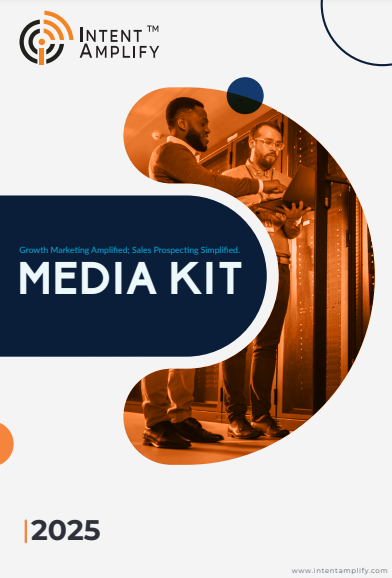
How to Create Quality MQLs: An Intent Amplify Playbook
- Last updated on: June 23, 2025
In today’s results-based B2B environment, marketing organizations are no longer measured by the number of leads generated, but by how many of them become actual revenue. An influx of bad MQLs engorges your pipeline, wastes the time of sales, and drives up campaign expenses. The actual problem in 2025 isn’t capturing leads; it’s faster and smarter qualifying the good ones.
That’s where Intent Amplify’s playbook fits in. We don’t merely assist teams in collecting marketing-qualified leads; we assist them in finding the ones that matter most. These are leads that align with your ideal customer profile, express active buying intent, and have the highest chances of closing.
In this article, we’re dissecting our end-to-end methodology for creating high-quality MQLs, founded on behavioral intelligence, predictive scoring, and sales alignment without a hitch. Whether you’re a growth-stage SaaS organization or an established enterprise, this playbook provides you with the framework and understanding to power a revenue-ready pipeline.
How does Intent Amplify define ‘High-Quality MQLs’?
At Intent Amplify, a high-quality MQL is not necessarily determined by engagement; it’s determined by accuracy. That implies the lead should match your Ideal Customer Profile (ICP), display in-market buying intent, and engage on multiple high-intent touchpoints. We don’t simply search for clicks and downloads; we monitor patterns, priorities, and purchase timelines. This three-dimensional perspective blends demographic fit, firmographic value, and behavioral signals, so sales do not spend time pursuing lukewarm prospects.
We think high-quality MQLs need to meet more than one criterion: score greater than a predictive benchmark, belong to an active buying cycle, and show solution-readiness. Let’s say a prospect from a target company continues to return to competitor comparison pages and attend product demos. That is not curiosity, that is actionable intent. With our solution, MQLs are scored and revalidated continuously, minimizing pipeline drop-offs and maximizing Sales Accepted Lead (SAL) rates. In the end, quality MQLs from Intent Amplify don’t simply appear nice on a dashboard—they close quicker.
Step 1: Define and Align Your Ideal Customer Profile (ICP)
Your high-quality MQL strategy starts with precision targeting, and that begins with your Ideal Customer Profile. An ICP outlines the types of companies that are most likely to benefit from your product and generate high lifetime value. This profile is built using firmographic data (industry, company size, revenue), technographic information (tools they use), and psychographic indicators (growth goals, challenges).
When you align your MQL filters with a clearly defined ICP, you remove noise and concentrate on value. Intent Amplify takes companies deeper by adding intent behavior on top of static ICP filters. So, rather than targeting “all mid-market HR software buyers,” you target “mid-market HR software buyers actively looking for onboarding automation solutions.” This concentrates your target but increases your close rate. The more targeted your ICP, the more effective your MQL pipeline.
Step 2: Capture Intent Signals Early and Often
Most high-intent leads begin to indicate interest well before form-filling. They visit solution pages, read analyst reports, search comparison terms, or ingest content on third-party sites. It is important to capture these signals in order to qualify the leads ahead of your rivals. At Intent Amplify, we monitor first-party and third-party intent signals, weaving them together into cohesive lead journeys.
This methodology keeps your MQLs from being mere folks who engaged with your company—those are actively searching for solutions you provide. For instance, a purchaser reading “how to automate webinars B2B” on multiple tech forums and browsing your integration page is a good lead even when they haven’t scheduled a demo yet. These micro-signals feed real-time scoring models that change in real time. Early signal capture translates to quicker handoffs, more effective sales conversations, and reduced lead-to-close cycles.
Step 3: Scoring Leads with a Predictive Model
Historical lead scoring models are static, rule-based, and default to assigning clickthroughs, downloads, or job titles some arbitrary value. While they’re better than nothing, these models aren’t sophisticated enough to represent the sophistication of buyer behavior today. Predictive scoring, on the other hand, applies AI models trained on historical conversion patterns to predict which leads have the highest chances of closing. At Intent Amplify, our scoring engine looks at hundreds of touchpoints and compares them to historical patterns that resulted in revenue.
The outcome? A lively score that changes along with buyer behavior. Say, for instance, whitepaper downloads formerly converted well, but demo requests currently show greater intent. The model changes accordingly. This makes your scoring model reactive and predictive—two of the most important characteristics to look for in determining high-quality MQLs. Most importantly, predictive scoring eliminates guesswork from your funnel. Your sales reps spend less time qualifying and more time closing.
Step 4: Leverage Personalization from Intent Data
Once you’ve identified a high-quality MQL, the next step is converting it into a Sales Qualified Lead (SQL). This requires a personalized, timely, and context-aware outreach strategy. Intent Amplify equips teams with detailed buyer journey insights—what content they viewed, which competitors they compared, and what keywords they searched for. With this context, SDRs and marketers can craft messages that speak directly to the lead’s needs.
According to Salesforce’s 2025 State of Marketing report, personalized content can improve MQL-to-customer conversion rates by up to 63%, proving that precision-targeted communication is more than a best practice—it’s a growth accelerator.
Rather than sending a generic “We’d love to give you a demo” email, try this instead: “I saw that your team is considering using automation tools for virtual events. I wanted to provide you with a quick comparison guide to illustrate how our platform handles multi-region webinars.” This degree of relevance translates to increased response rates, more booked meetings, and improved trust establishment from the beginning. High-value MQLs deserve high-value conversations—and intent-led personalization enables that.
Step 5: Automate Nurturing Without Losing Human Touch
Not all MQLs are sales-ready upon first contact. Some are weighing options or awaiting internal approval. Enter nurture automation. But quality MQLs shouldn’t be plunked into boring drip campaigns. At Intent Amplify, we recommend dynamic nurture tracks powered by behavioral segmentation. If a lead expresses interest in a particular product feature, their content path changes accordingly.
For example, someone interacting with security compliance content is notified about certifications, risk mitigation, and business scalability. Another lead interested in price gets ROI calculators and customer success stories. This intent-based automation makes sure that even if an MQL takes weeks to become an opportunity, your messaging still stays relevant and helpful. The human touch enters in the form of triggered outreach—when specific behaviors indicate a level of readiness for direct communication, your reps are immediately alerted.
Step 6: Align Sales and Marketing With Feedback Loops
Creating high-quality MQLs is not merely a marketing task—it’s a revenue task. So constant alignment between sales and marketing is crucial. Intent Amplify creates automated feedback loops whereby sales reps can mark lead quality, conversion reasons, and disqualification information. This information updates MQL criteria in real-time, so ensuing leads are better aligned with sales expectations.
For instance, if reps are continuously disqualifying leads from one particular industry, marketing can modify targeting filters. If specific behaviors are associated with quicker closes, those touchpoints can be given more weight in scoring. Feedback loops also reveal gaps, such as messaging misalignment or absent personas, that are preventing conversions. With continued alignment, MQL creation becomes an ever-refined process instead of a static pipeline. It’s a loop, not a line.
Step 7: Measure What Matters, Not Just Volume
Quantity is often confused with success in MQL generation. But here at Intent Amplify, we concentrate on quality metrics that have a direct relationship to revenue. That means MQL-to-SQL conversion rate, velocity to opportunity stage, average deal size from MQLs, and total pipeline influence. These KPIs allow you to determine whether your MQLs are actually driving revenue or simply generating dashboard noise.
Monitoring these metrics allows marketing to demonstrate its impact on revenue and optimize campaign approaches. If MQLs from paid advertising have higher conversion rates than gated content, the budget can be redistributed accordingly. If specific intent signals predict greater deal sizes, scoring can be calibrated to value them more highly. By tracking quality rather than vanity metrics, your team ensures that each MQL created is one step further along the path to being closed-won.
A Playbook Designed for Pipeline Precision
Exceptional MQL creation in 2025 is not about more leads—it’s about quality ones. The B2B market is more competitive, data-rich, and buyer-centric than ever. Intent Amplify’s methodology integrates rich behavioral insights, predictive analytics, and real-time personalization to expose leads that truly convert. From identifying your ICP to closing the loop with sales, each step of our playbook is crafted with precision, velocity, and ROI.
If you’re still relying on outdated scoring models, generic nurture tracks, or volume-based KPIs, now is the time to rethink your strategy. High-quality MQLs aren’t just a pipeline metric—they’re the foundation of sustainable growth. And with intent-driven insight at the core, every lead becomes more than a name—it becomes a real opportunity.
FAQs
1. What is the difference between a regular lead and a high-quality MQL?
A regular lead may have shown minimal engagement, such as visiting a landing page. A high-quality MQL, on the other hand, demonstrates strong intent signals, aligns with your Ideal Customer Profile (ICP), and meets specific behavioral thresholds—like repeated visits, high-value content interactions, and competitive research—making them much more likely to convert into a customer.
2. How does Intent Amplify determine if an MQL is high quality?
Intent Amplify uses a combination of firmographic filters, behavioral signals, and AI-driven scoring models. It looks beyond basic actions like form fills and evaluates deep intent signals such as content consumption patterns, in-market behavior, and keyword-level interest, across first- and third-party data sources. Leads that align with ICP criteria and show purchase readiness are scored as high-quality MQLs.
3. Can predictive scoring improve MQL quality?
Yes. Predictive scoring models analyze historical conversion data to identify patterns that lead to closed deals. Instead of relying on static rules, predictive models dynamically adjust scoring weights based on actual outcomes. This increases the likelihood that an MQL will convert and eliminates guesswork, making your sales outreach more focused and impactful.
4. What intent signals should marketers prioritize for MQL scoring?
Marketers should prioritize signals like product page visits, pricing interest, competitor comparisons, high-intent search terms, and event attendance. These behaviors often indicate that the prospect is actively evaluating solutions. Intent Amplify uses these indicators in real-time scoring, allowing marketing and sales teams to act while the buyer is still in a decision-making phase.
5. How often should MQL scoring models be updated?
MQL scoring models should be reviewed quarterly or whenever there’s a noticeable drop in conversion rates. Buyer behavior evolves with market shifts, product changes, and competitive dynamics. Intent Amplify’s system supports adaptive scoring that updates based on new behavioral data, ensuring that your lead qualification stays aligned with actual buying patterns.




